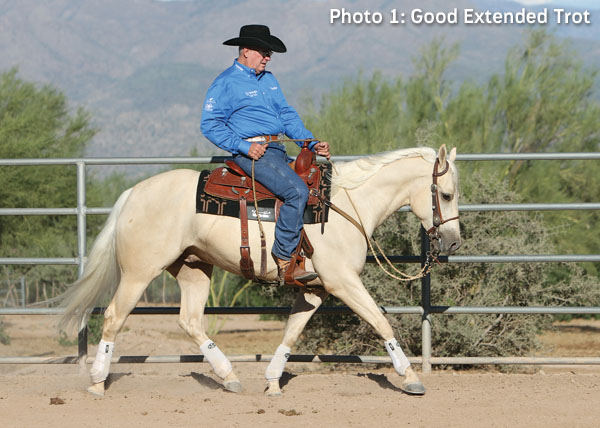Q When the judge or a pattern calls for an extended trot, as in ranch riding, I have a hard time keeping my horse in that gait. Rather than maintain an extended trot, he breaks into a lope. However, if I don’t really push him, he won’t truly extend his gait. How can we work on this at home to have better success at a show?
Carlee Carter, Minnesota
A Understanding what goes into a correct extended trot is crucial to executing the gait correctly and maintaining it. Here, I’ll show photos of proper extension, so you can better understand what the judge is looking for. I’ll also offer tips for working on the gait at home.
Take a Close Look
First, let’s evaluate Photo 1. This horse is on a slack rein, working at an extended trot. The loose rein isn’t required, and in some horses it might hamper collection, but I’m using my seat and legs to drive him forward and ride him from back to front. The reach of his left hind foot underneath his body demonstrates this drive. His right front leg is really reaching out there in full extension, which is a result of his free-swinging shoulder. I look like I’m really concentrating, which could tip off the judge that the horse isn’t quite in balance, but the horse is obedient, in control, and showing proper extension of the gait.

In Photo 2, we see a lot of the same characteristics. The horse looks good, but he’s a little behind the vertical. I’d like to see him a little flatter over his neck, with less over-flexion in his face, but it’s a good overall picture. One key to maintaining an extended trot, and not break into a lope, is that the rider must stay cadenced with the horse while sitting the trot. You shouldn’t post, but rather show that the horse’s gait is smooth enough to sit across a pasture.

Photo 3 shows a bumpier ride—and I’m posting rather than sitting the trot. It’s hard for me to drive my horse from the hind end when I’m leaned forward instead of sitting in the saddle. My body position has also caused my horse to hollow his back, lift his head, and put his nose out.

Finally, in Photo 4, it looks like my horse could break into a lope, due to his head being in an upright position and his back hollowing out. When a horse lopes off, he lifts his shoulders and elevates his head and neck. If I’d relax and ride my horse from back to front and think about driving his hind legs, he’d stay in the proper gait.

Training the Extended Trot
For the best results, be sure that your horse can maintain a level topline and drive from his hind end forward with a rhythmic leg movement. Remove your spurs, and use your heels and your legs so you can close them around your horse’s body and really drive him forward. With spurs, you might get a more abrupt response to the leg pressure you’ll need to encourage your horse to drive from behind.
Working at a jog first, move your horse forward into the bridle by making contact with the bit, and hold him there while you drive his hind end forward with your legs and heels. This is “riding back to front,” and it’s the key to collection at any gait.
Begin at a slow trot, then add some more forward motion, and then finally ask for additional extension. It’s imperative that you find your horse’s “sweet spot,” where you’re still in his comfort zone, before he’d ordinarily break into a lope. Some horses are comfortable reaching way forward with their front foot in a trot stride; others are more conservative. A lot of this has to do with conformation and whether the horse’s shoulder swings freely. You can see in Photo 1 that the horse I’m riding reaches really far forward and points his toe out in front of him. A horse built like this will be easier to drive into extension than a horse with a shorter stride.
Once you define your horse’s extension comfort zone, your rhythm is key. You must maintain cadence with your horse to continue with that speed. If you speed up and get in front of his cadence, he’ll break into a lope. If you slow down, you’ll cause him to lose focus and extension. As you work within your horse’s comfort zone, you might be able to stretch his sweet spot to further extension by driving him forward and maintaining contact with his face to keep his poll level with or slightly above his withers.
Put the Brakes on Breaking Gait
Once you have a correct, collected extended trot that stays within your horse’s comfort zone, if he still breaks gait, it’s time to correct him. But it’s not a harsh correction—you won’t slam him into the ground. That’s the No. 1 mistake I see riders make: a harsh correction that increases the horse’s stress.
When your horse breaks into a lope, slowly draw him into the ground, regain collection, and start over again with the slow jog, moderate extension, and then back up to the “sweet spot” where he’s comfortable extending. Don’t push him to his gait-breaking point, usually given away by his raised head and shoulder that indicate he’s about to strike off into a lope.
If he continues to break into a lope, go back to basic suppling exercises. Get your horse more accustomed to leg pressure, flexing at the poll, and bending. His responsiveness to your legs and willingness to flex and bend play major roles in gait extension.
Al Dunning, Scottsdale, Arizona, has produced world champion horses and riders in multiple disciplines. He’s been a professional trainer for more than 40 years, and his expertise has led him to produce books, DVDs, and his own online mentoring program, Team AD International (teamadinternational.com).






